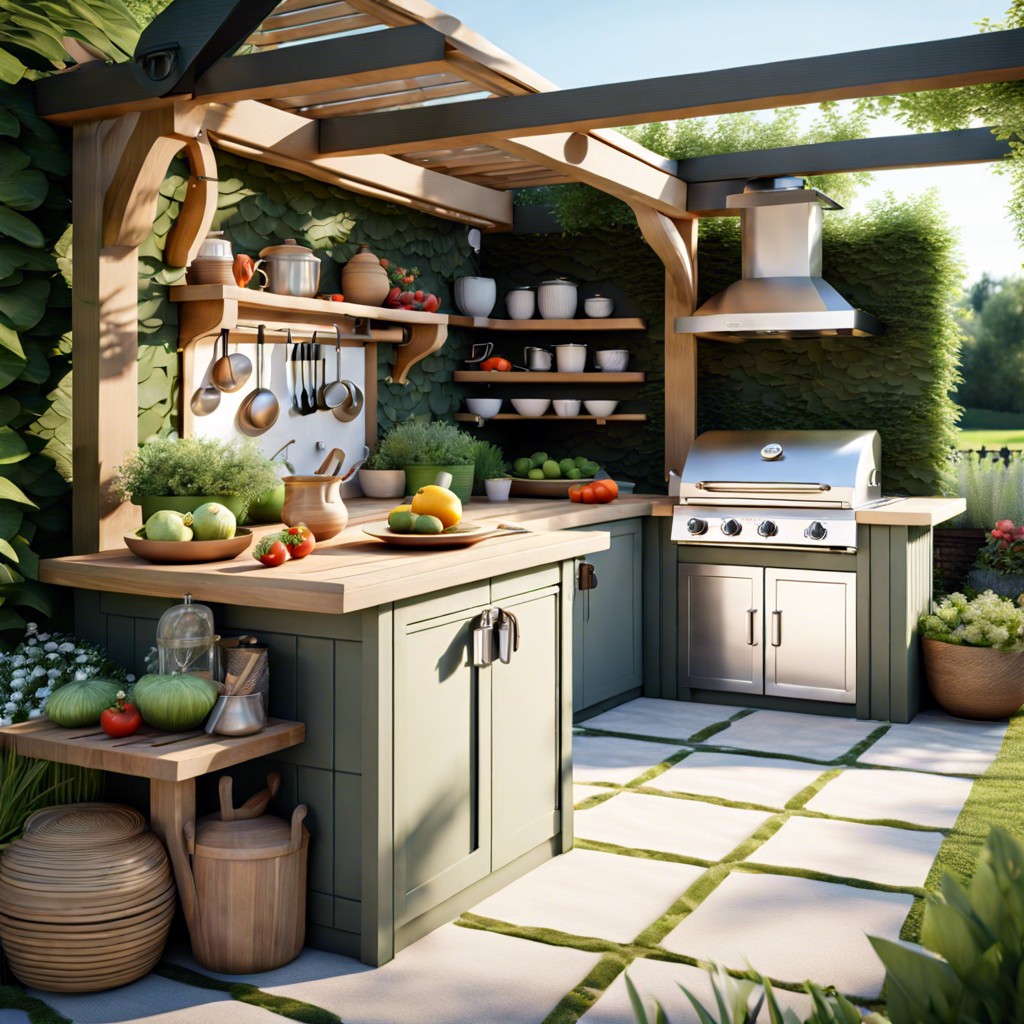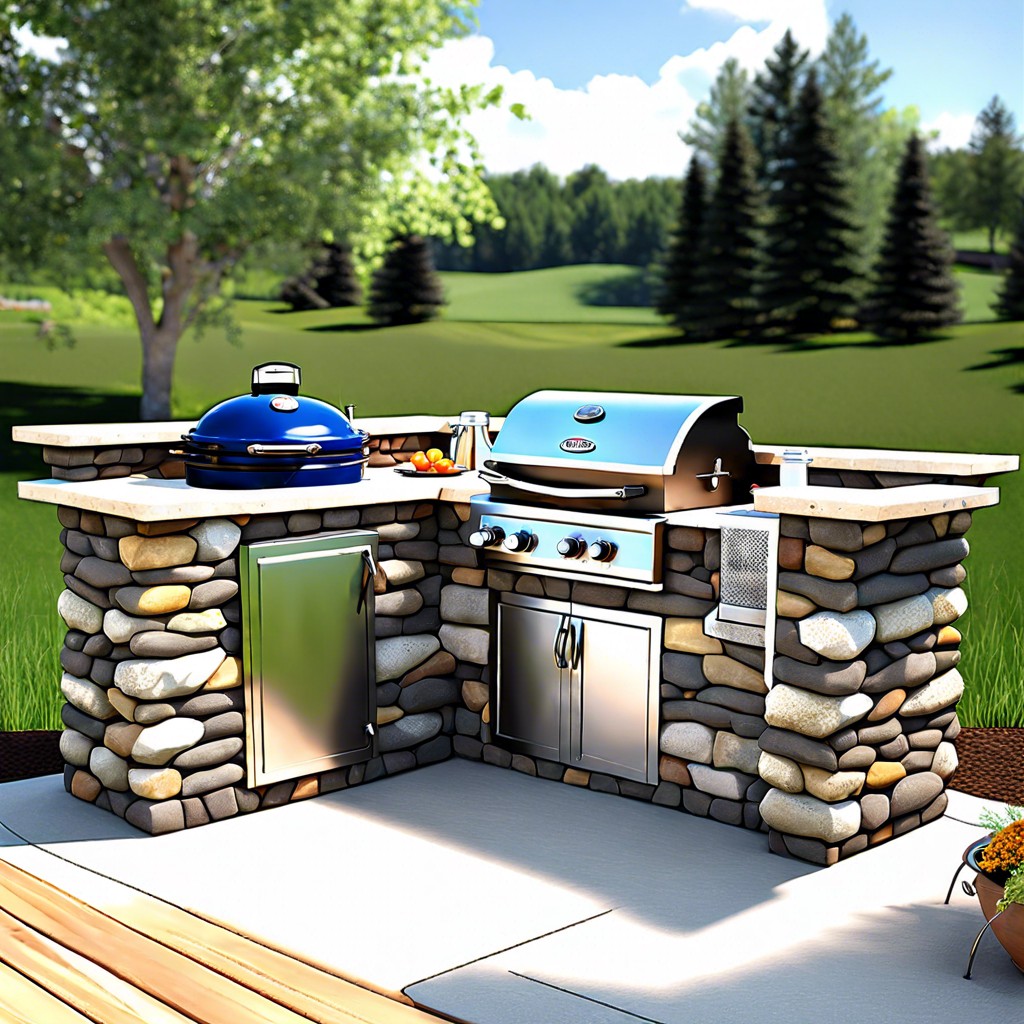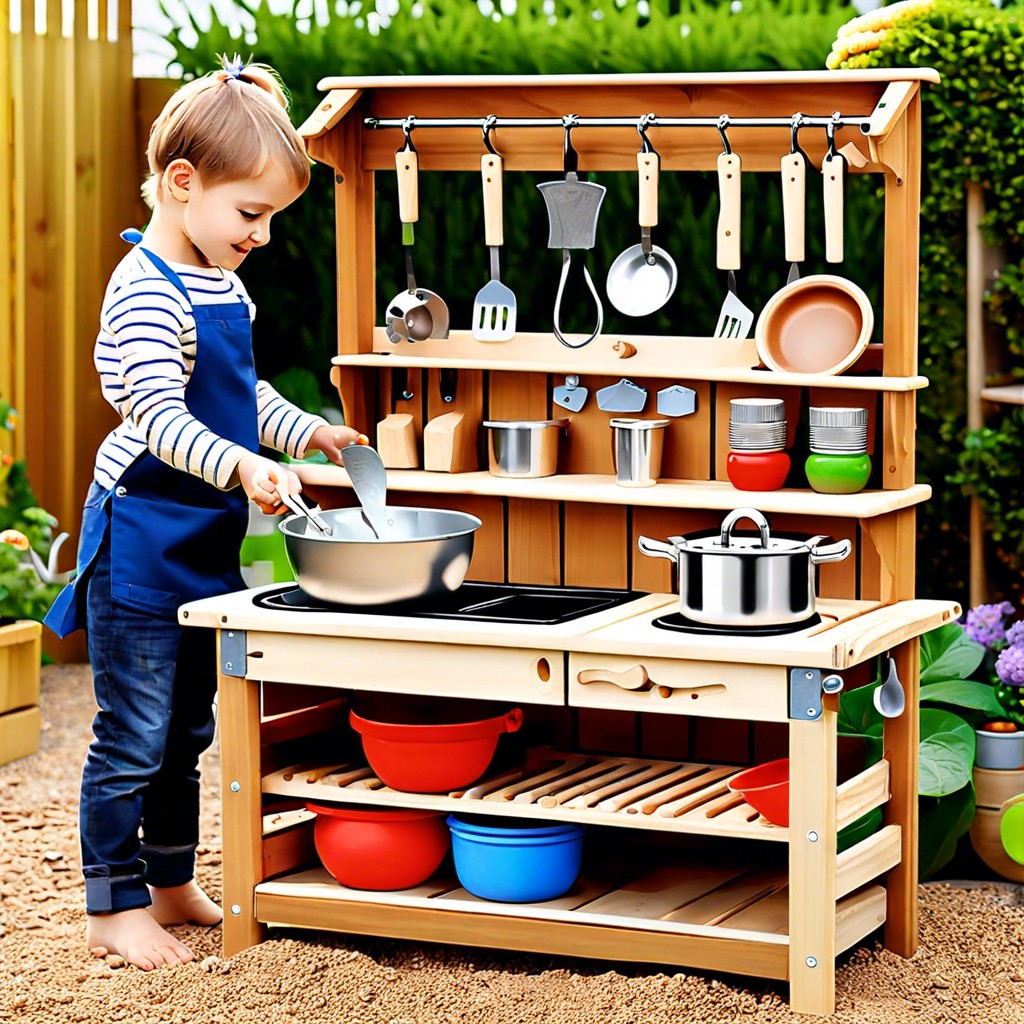Last updated on
Discover the perfect spot for your outdoor kitchen by exploring various factors and ideas that will enhance your culinary experience under the open sky.
Outdoor kitchens have become increasingly popular in recent years, and for good reason. They allow you to take your cooking skills outside and enjoy the fresh air while entertaining guests.
However, deciding where to place your outdoor kitchen can be a daunting task. You want it to be convenient for cooking but also aesthetically pleasing and functional.
In this article, we will explore some of the best places to put an outdoor kitchen so that you can make the most of your outdoor space.
What's Inside
Assessing Your Space
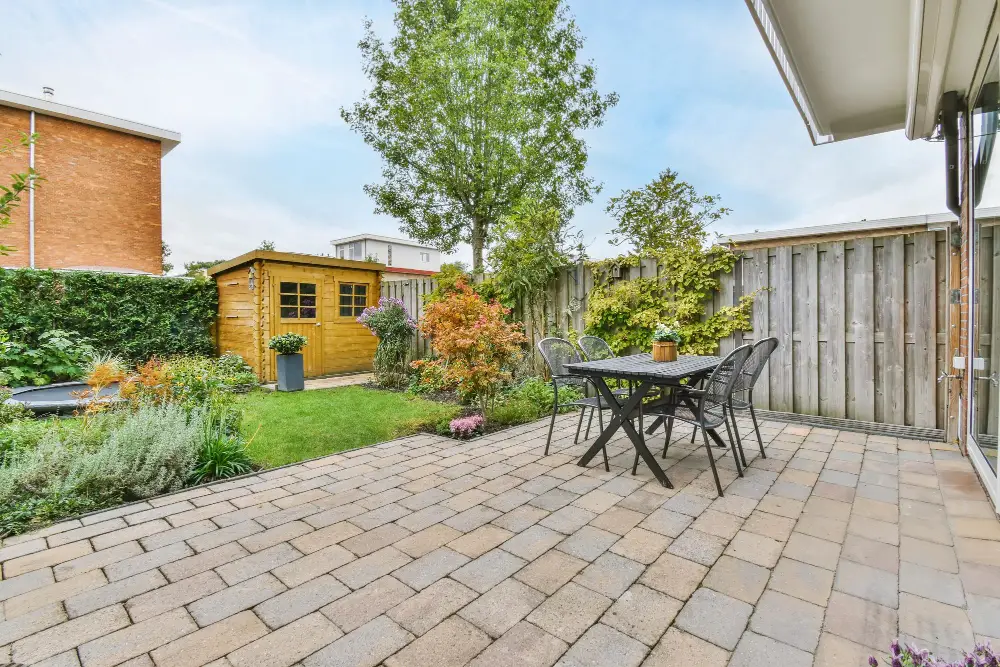
Before you start planning your outdoor kitchen, it’s essential to assess the space you have available. Consider the size and shape of your yard or patio, as well as any existing structures that may impact where you can place your outdoor kitchen.
Take note of any trees or shrubs that could provide shade or privacy but also consider their root systems and how they might affect construction.
Think about how much space you need for cooking and entertaining. Do you want a small grill with a few seats around it? Or do envision an elaborate setup with multiple cooking stations, seating areas for guests to relax in while food is being prepared?
By assessing your space first before making any decisions on location or design elements will help ensure that everything fits together seamlessly without overcrowding the area.
Choosing a Location
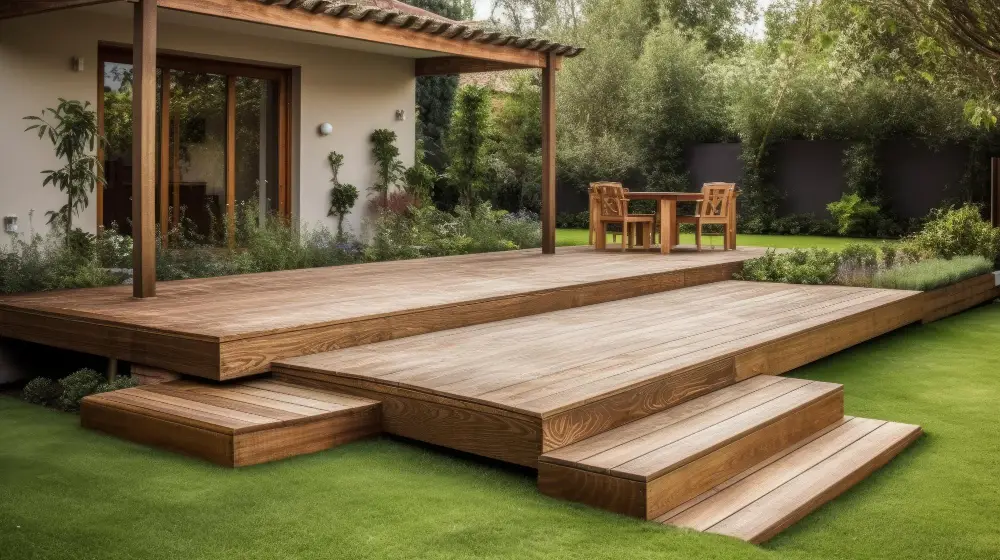
First and foremost, you want it to be easily accessible from your home so that you can quickly move food and supplies back and forth. Think about how much space you have available in your backyard or patio area.
You don’t want the kitchen to take up too much room or feel cramped.
Another important consideration is the view from where you plan on placing your outdoor kitchen. If possible, choose a spot with an attractive view of nature or landscaping features such as gardens or water features.
Lastly, consider any potential obstacles that may affect placement such as trees blocking sunlight during certain times of day or wind patterns affecting cooking conditions.
Proximity to Your Home
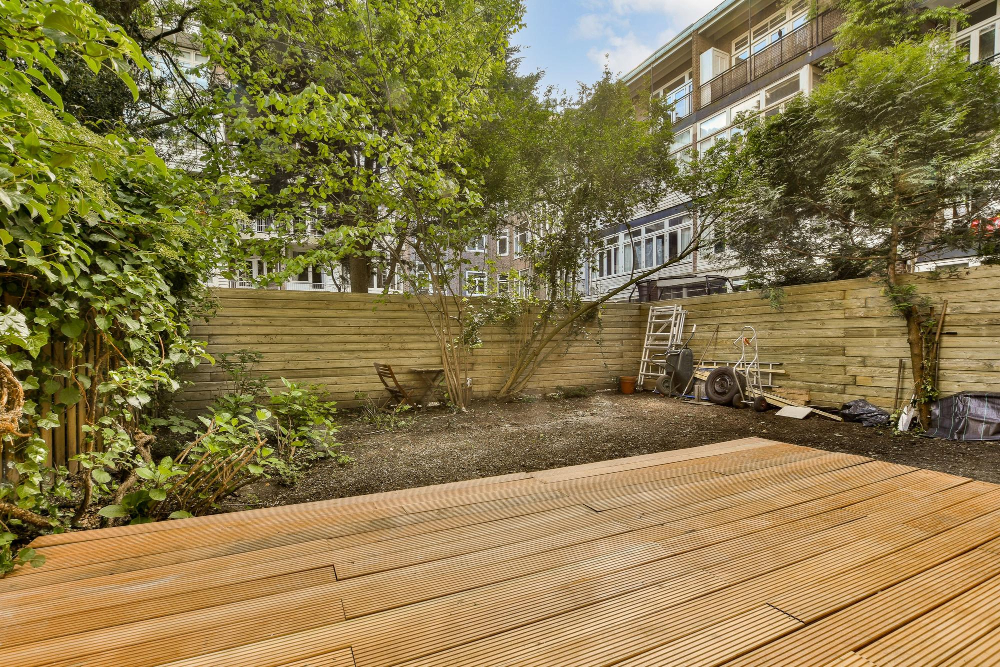
You want it close enough that you can easily access it from inside, but not so close that smoke and cooking odors will waft into your house. Ideally, you should position the outdoor kitchen near a door or window in your home’s kitchen for easy access.
Another benefit of having an outdoor kitchen located near your indoor one is that it makes food preparation and serving more convenient. You won’t have far to travel with heavy platters or hot dishes, which means less risk of spills or accidents.
However, if you’re concerned about smoke and cooking smells entering your home through open windows or doors while using the grill, consider installing a ventilation system in both kitchens. This will help keep air flowing freely between indoors and outdoors while also reducing any unpleasant odors.
Choosing a location for an outdoor kitchen requires careful consideration based on various factors such as convenience, functionality as well as aesthetic appeal.
Weather and Climate Considerations

You want your kitchen to be functional throughout the year, regardless of the weather conditions. If you live in an area with harsh winters or frequent rainstorms, you may need a covered area for your outdoor kitchen that provides shelter from the elements.
On the other hand, if you live in a hot and dry climate, shade is essential for keeping cool while cooking outdoors. Consider adding umbrellas or awnings over seating areas as well as above cooking stations.
It’s also important to think about how wind affects your outdoor space. Strong winds can blow out flames on gas grills or cause smoke from charcoal grills to blow into unwanted areas of your yard.
Make sure that any structures around your outdoor kitchen are sturdy enough not only for everyday use but also during inclement weather.
Access to Utilities and Power Supply
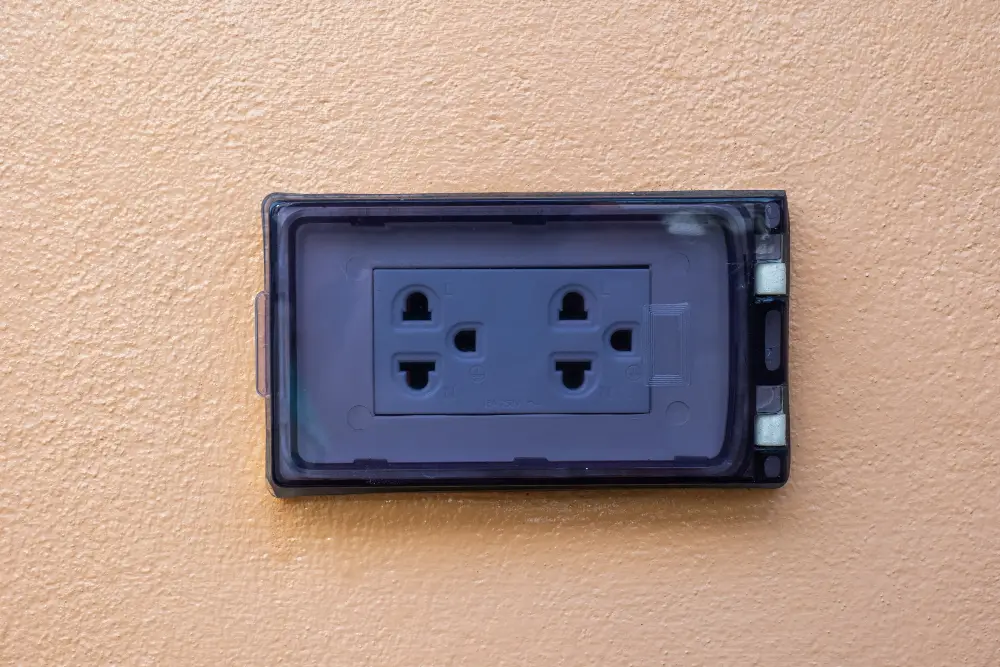
You’ll need a reliable source of electricity for lighting, cooking appliances, and other electrical equipment. If you’re building an outdoor kitchen from scratch or renovating an existing one, make sure that the location you choose has easy access to electrical outlets.
If your home is already equipped with an outdoor outlet or if there’s one nearby that can be used for your new setup without overloading the circuit breaker box in your house then great! However, if not then hiring a licensed electrician will be necessary. They can help install additional circuits as well as ground fault circuit interrupters (GFCIs) which are required by code in most areas.
Another utility consideration is water supply lines and drainage systems especially when installing sinks or dishwashers outdoors. Make sure these are installed properly so they don’t cause any damage during heavy rainfalls or snow melts.
Outdoor Kitchen Styles
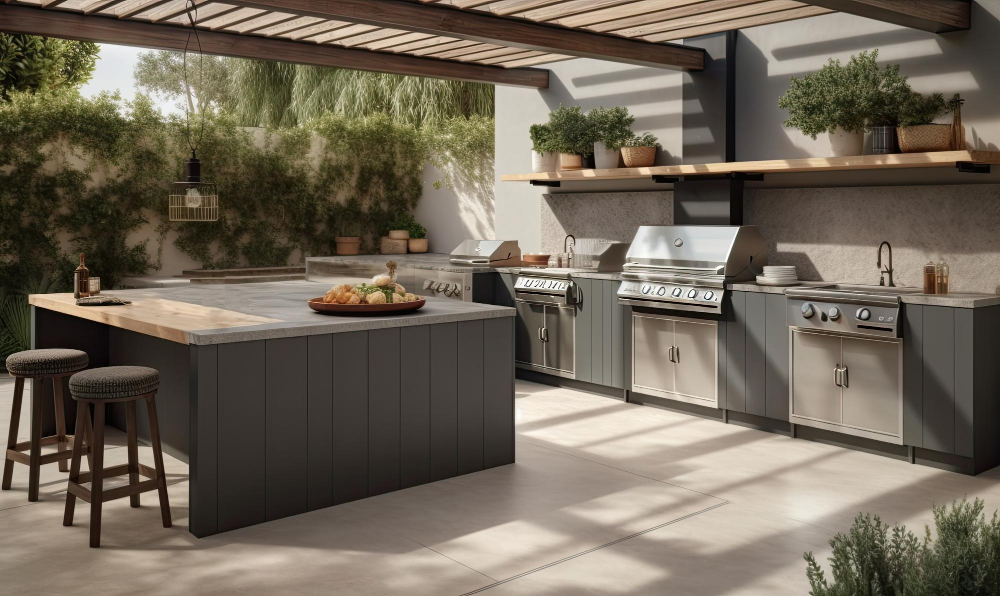
The style you choose will depend on your personal taste and the overall aesthetic of your outdoor space. Some popular styles include traditional, Mediterranean, contemporary, farmhouse-style or industrial.
Traditional outdoor kitchens often feature natural materials such as stone or brick for their countertops and flooring. They may also have wood cabinetry with intricate details that add character to the space.
Mediterranean-style outdoor kitchens are inspired by coastal regions like Spain or Italy. These designs typically incorporate bright colors such as blue and yellow along with decorative tiles for backsplashes.
Contemporary outdoor kitchen designs focus on sleek lines and minimalism while still providing functionality through high-tech appliances like built-in grills or refrigerators.
Farmhouse-style is another popular option that features distressed wood finishes paired with vintage-inspired hardware for a cozy yet functional look.
Industrial style is perfect if you want an edgy vibe outdoors; it incorporates metal accents into its design elements which can be seen in exposed pipes used as shelving brackets or pendant lighting fixtures made out of steel pipes.
Material Selection
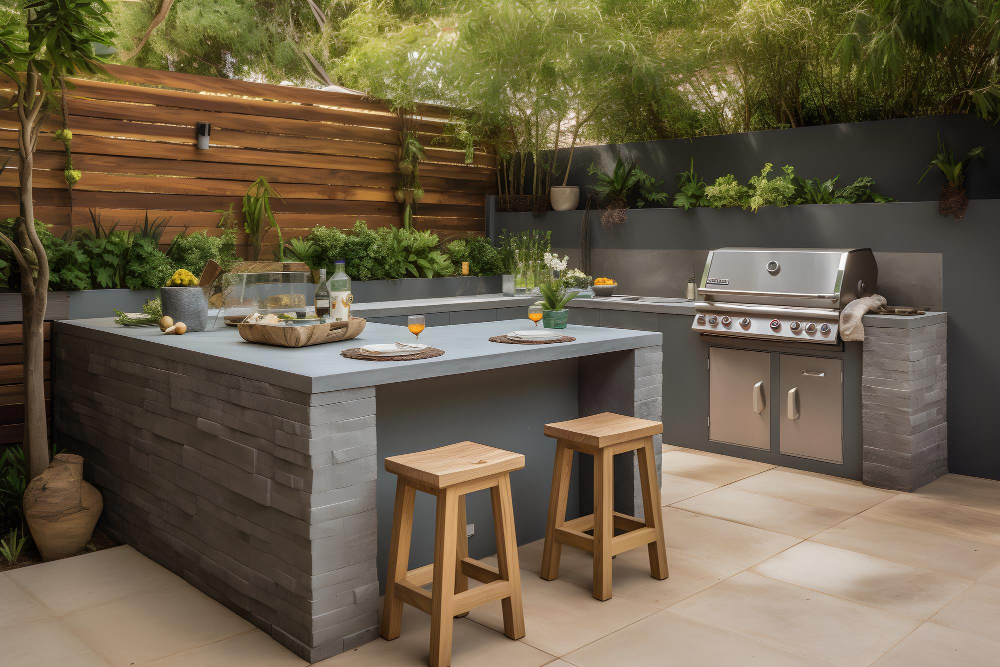
You want your outdoor kitchen to be durable and able to withstand harsh weather conditions while still looking stylish. Some popular options for outdoor kitchens include stainless steel, concrete, brick or stone veneer.
Stainless steel is a great choice for those who want a modern look that’s easy to clean and maintain. It’s also resistant to rust and corrosion which makes it perfect for use in areas with high humidity or saltwater exposure.
Concrete countertops are another popular option as they’re highly customizable in terms of color and texture. They’re also heat-resistant which means you can place hot pots directly on them without worrying about damage.
Brick or stone veneer gives your outdoor kitchen a classic look that blends seamlessly with nature. These materials are strong enough to withstand extreme temperatures but may require more maintenance than other options due to their porous nature.
Safety Precautions and Fire Prevention
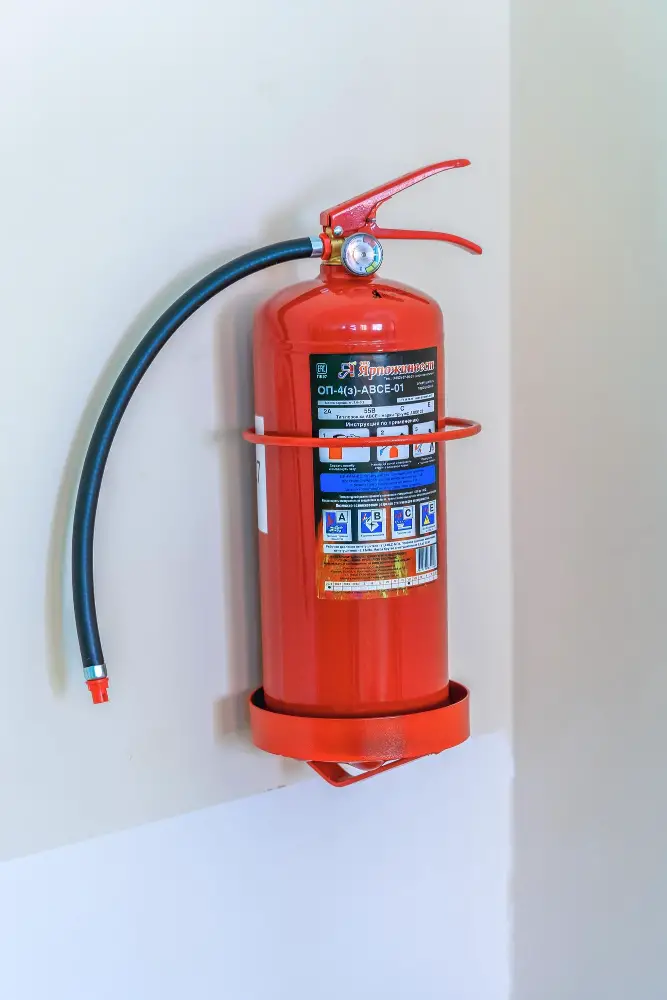
With open flames and gas lines in use, there is an increased risk of fire hazards. Therefore, taking necessary precautions can prevent accidents from happening.
One way to ensure safety is by placing the grill or cooking station away from any flammable materials such as trees or bushes. Make sure that your outdoor kitchen has proper ventilation and airflow so that smoke does not accumulate in one area.
Another important aspect of fire prevention is keeping a fire extinguisher nearby at all times. It’s also crucial to regularly clean your grill and remove grease buildup which can easily ignite if left unattended for too long.
Lastly, consider installing an automatic shut-off valve on your gas line which will cut off the fuel supply if there’s ever a leak detected.
Design and Layout Tips
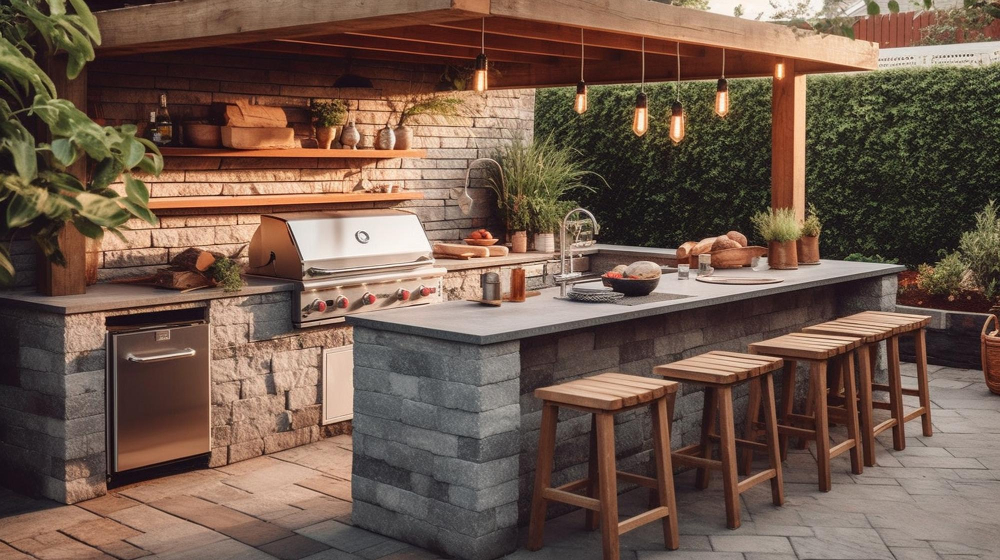
The design should complement your home’s architecture while also reflecting your personal style. When planning the layout, consider how you will use the space and what features are most important to you.
One popular trend in outdoor kitchen design is creating a focal point with a large grill or cooking station as the centerpiece. This can be surrounded by additional counter space for food prep, serving areas, sinks for washing dishes or hands-free faucets that make cleaning up easier.
Another essential aspect of designing an outdoor kitchen is ensuring there is enough storage space for all of your cooking tools and equipment. Cabinets can be built into walls or freestanding units placed around workstations.
When selecting materials such as countertops, flooring options like tile or stone pavers should be considered since they are durable enough to withstand harsh weather conditions without cracking over time due to temperature changes from hot grills being used nearby during summer months when temperatures soar high above 90 degrees Fahrenheit (32 Celsius).
Cooking Stations and Appliances
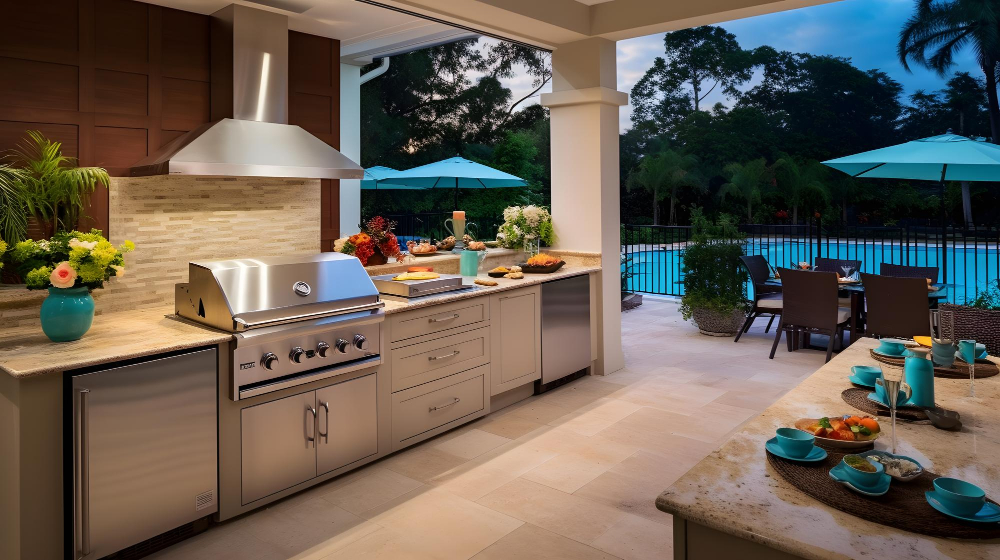
The most common appliance for an outdoor kitchen is a grill, but there are many other options available as well. Some popular choices include pizza ovens, smokers, rotisseries, side burners for sauces or soups and even refrigerators.
When selecting your appliances consider how often you will use them and what type of food preparation they require. For example if grilling is going to be the main focus then investing in a high-quality grill with multiple burners may be worth it.
Another important factor when choosing cooking stations is their placement within the overall design of your outdoor kitchen. You’ll want to make sure that everything flows together seamlessly so that preparing meals outdoors feels effortless.
Outdoor Seating and Dining Areas
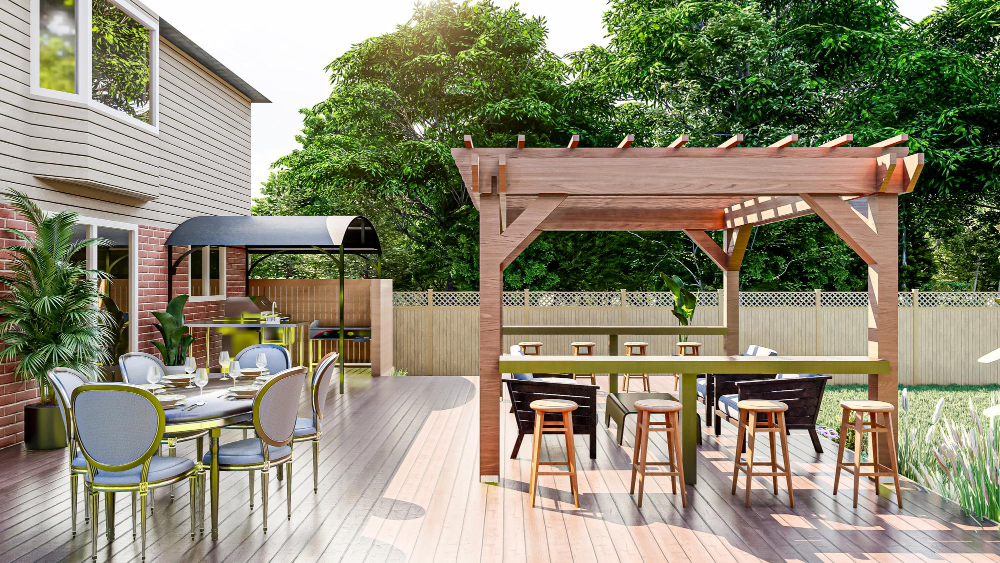
They provide a comfortable space for you and your guests to relax, dine, and enjoy the beautiful surroundings. When choosing outdoor furniture, it’s important to consider durability as well as style.
Look for materials that can withstand the elements such as aluminum or teak wood.
When designing your seating area, think about how many people you want to accommodate comfortably. A large table with plenty of chairs is perfect for hosting dinner parties or family gatherings while smaller bistro sets work well in more intimate settings.
In addition to tables and chairs, consider adding other features such as benches or lounges where guests can sit back and relax after a meal. Outdoor rugs can also add warmth underfoot while defining different zones within your outdoor space.
Outdoor Cabinetry Options
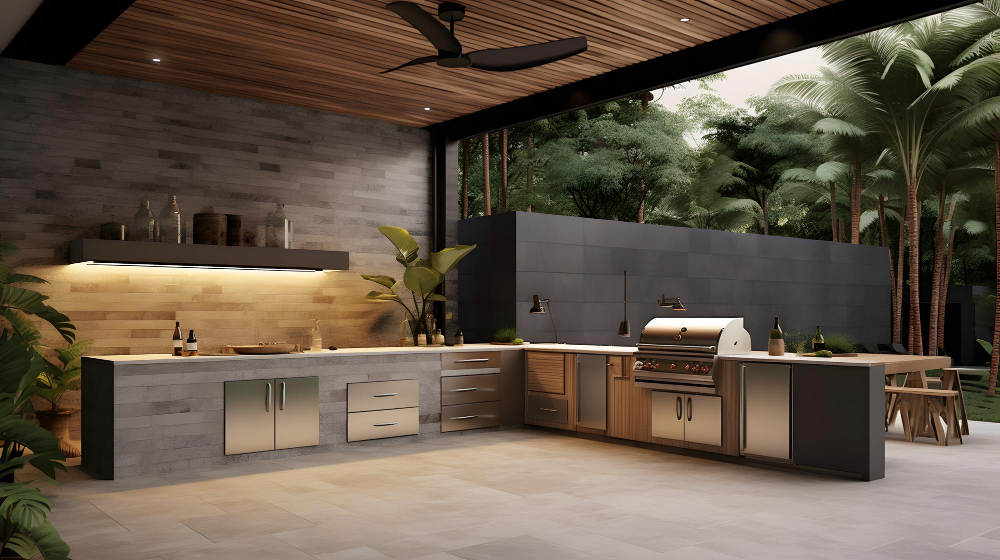
It provides storage space for your cooking utensils, plates, and other essentials while also adding to the overall aesthetic appeal of your outdoor living area. When choosing cabinets for your outdoor kitchen, it’s important to consider durability and weather resistance.
Stainless steel cabinets are a popular choice due to their ability to withstand harsh weather conditions without rusting or corroding. They are also easy to clean and maintain.
Another option is marine-grade polymer cabinetry which is resistant against moisture damage caused by rain or humidity. This type of cabinet material can be customized in various colors and styles that will complement the design theme you have chosen for your backyard oasis.
Wooden cabinets can add warmth and character but require more maintenance than stainless steel or polymer options as they need regular sealing treatments against water damage from rainwater exposure.
Countertop Choices
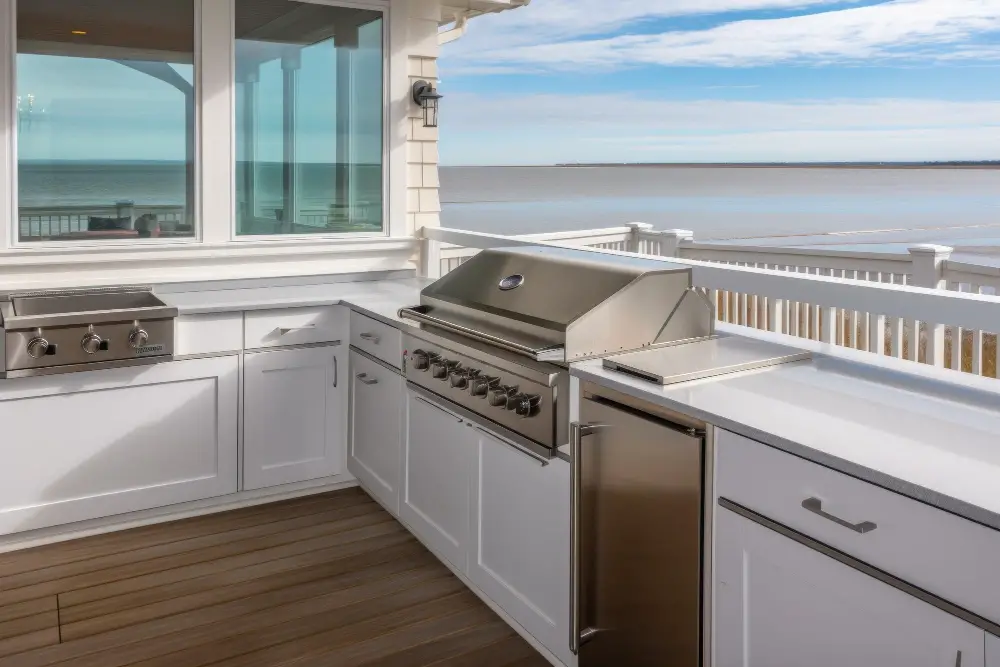
First and foremost, you want a material that is durable and can withstand the elements. Some popular options include granite, concrete, stainless steel, tile or natural stone.
Granite is a great choice because of its durability and resistance to heat and scratches. It also adds an elegant touch to any outdoor space with its unique patterns.
Concrete countertops are another option that has become increasingly popular in recent years due to their versatility in design options such as color choices or embedded objects like shells or stones.
Stainless steel countertops offer a sleek modern look while being easy-to-clean but may show fingerprints more easily than other materials.
Tile counters provide endless possibilities for customization with various colors shapes sizes textures available on the market today making them perfect if you’re looking for something unique yet functional at once!
Flooring and Foundation
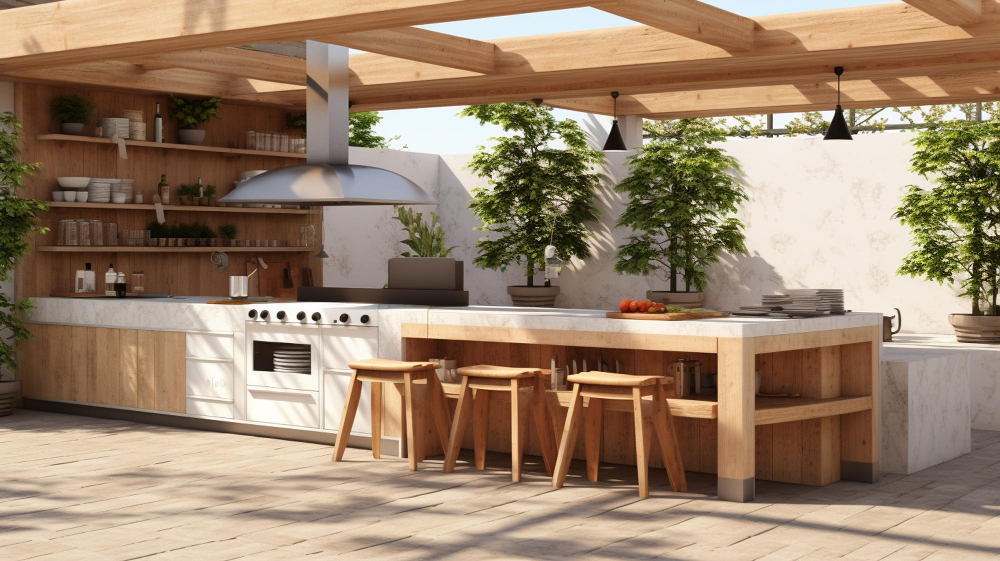
Concrete is a popular choice for its durability and low maintenance. It can be stamped or stained to mimic the look of other materials such as stone or brick.
Another option is natural stone like slate or flagstone which adds an elegant touch but requires more upkeep than concrete.
The foundation of your outdoor kitchen should also be considered carefully since it will support the weight of all appliances and furniture in your space. A solid foundation ensures stability while cooking on heavy grills or using large appliances like pizza ovens.
Lighting for Functionality
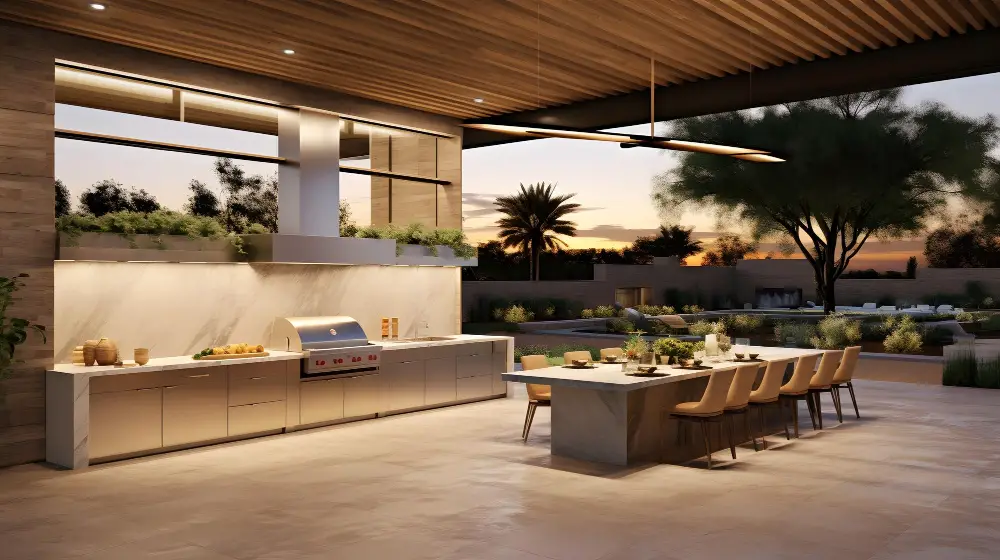
Proper lighting not only enhances the ambiance but also ensures safety while preparing food. When considering lighting for your outdoor kitchen, it’s important to think about functionality first.
One option is to install task lighting above each cooking station so that you can see what you’re doing when chopping vegetables or grilling meat. Pendant lights are a popular choice for this purpose as they provide focused light without taking up too much space.
Another idea is to incorporate ambient lighting around the dining area and seating areas using string lights or lanterns hung from trees or pergolas. This creates a warm and inviting atmosphere perfect for hosting dinner parties with friends and family.
Don’t forget about safety when it comes to your outdoor kitchen’s electrical system. Make sure all wiring meets local building codes, use weather-resistant fixtures designed specifically for outdoor use, and consider installing motion-activated security lights around the perimeter of your property.
Ventilation and Airflow
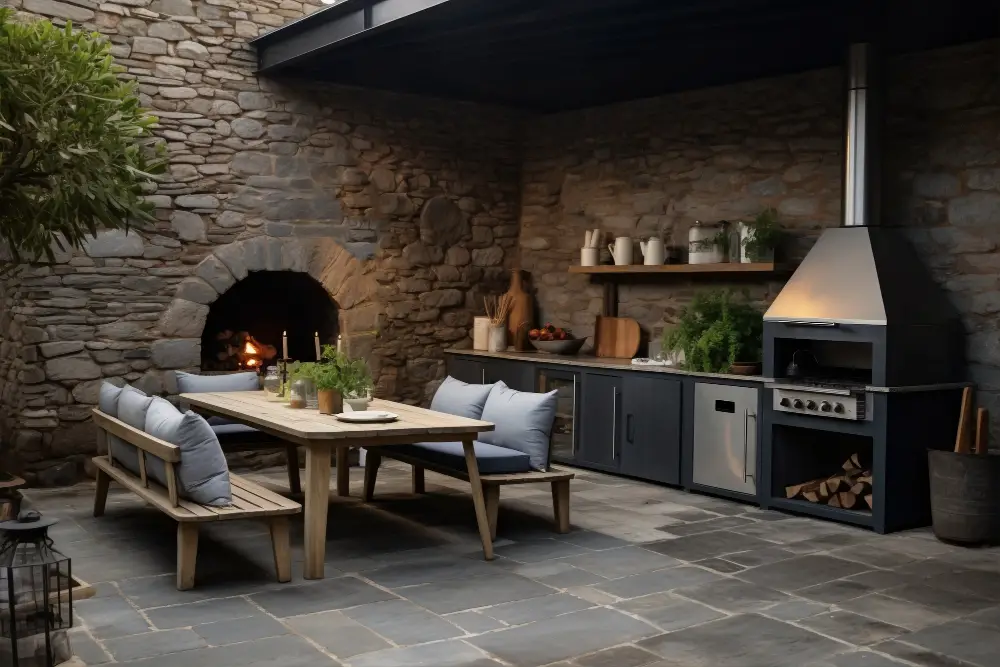
Without adequate ventilation, smoke from the grill can accumulate in the cooking area, making it uncomfortable for you and your guests. Poor airflow can cause heat buildup that may damage appliances or even pose a fire hazard.
One way to ensure good air circulation is by placing your outdoor kitchen in an open area with plenty of space around it. This will allow air to flow freely through the space while also providing ample room for people to move around comfortably.
Another option is installing a range hood above your grill or cooktop. A range hood will help remove smoke and fumes from the cooking surface while also preventing grease buildup on nearby surfaces.
Consider adding fans or other forms of mechanical ventilation if necessary. These can be especially useful if you live in an area with high humidity levels or frequent rainstorms that could affect natural airflow patterns.
Storage Solutions
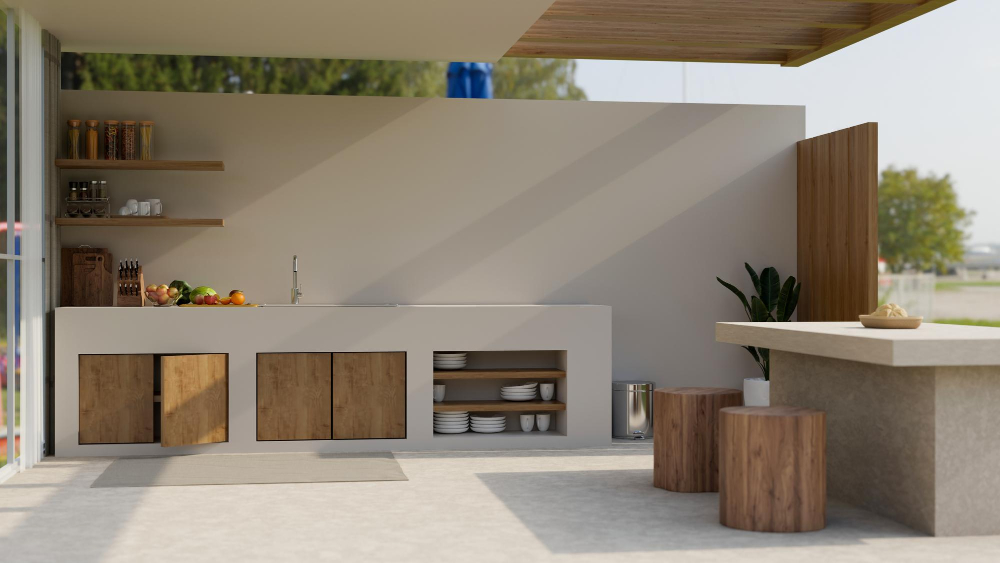
You want to make sure that all your cooking utensils, plates, and ingredients are within reach while you’re preparing meals. There are many different storage options available for outdoor kitchens, including built-in cabinets and drawers.
Built-in cabinets provide ample space for storing pots and pans as well as other cooking essentials like spices or oils. They can be made from a variety of materials such as stainless steel or wood depending on the style of your kitchen.
Drawers are another great option for storing smaller items like cutlery or grilling tools. They can also be used to store larger items such as serving platters or baking sheets.
When choosing storage solutions for your outdoor kitchen, it’s important to consider how much space you have available and what types of items you will need to store. Think about whether you want open shelving units that allow easy access but may require more maintenance than closed cabinetry with doors.
Shelter and Shade
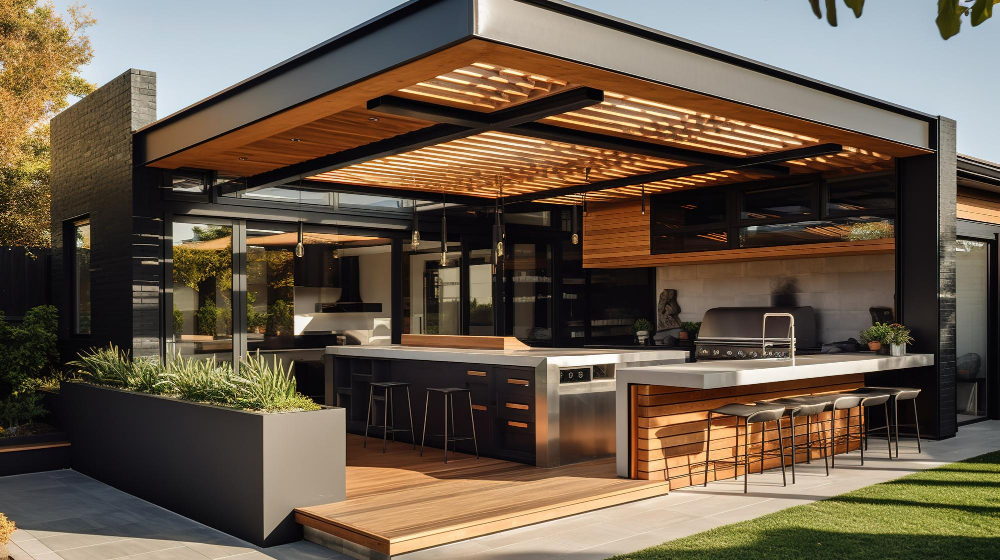
While cooking outside can be a fun experience, you don’t want to be caught in the rain or exposed to harsh sunlight for extended periods of time. That’s why incorporating shelter and shade into your design is crucial.
One option is building a pergola or gazebo over your outdoor kitchen area. This will provide both shade from the sun and protection from light rain showers.
You could also opt for an awning that can retract when not needed.
Another idea is adding an umbrella table or freestanding umbrellas near seating areas so guests have some relief from direct sunlight while enjoying their meals.
Landscaping and Design
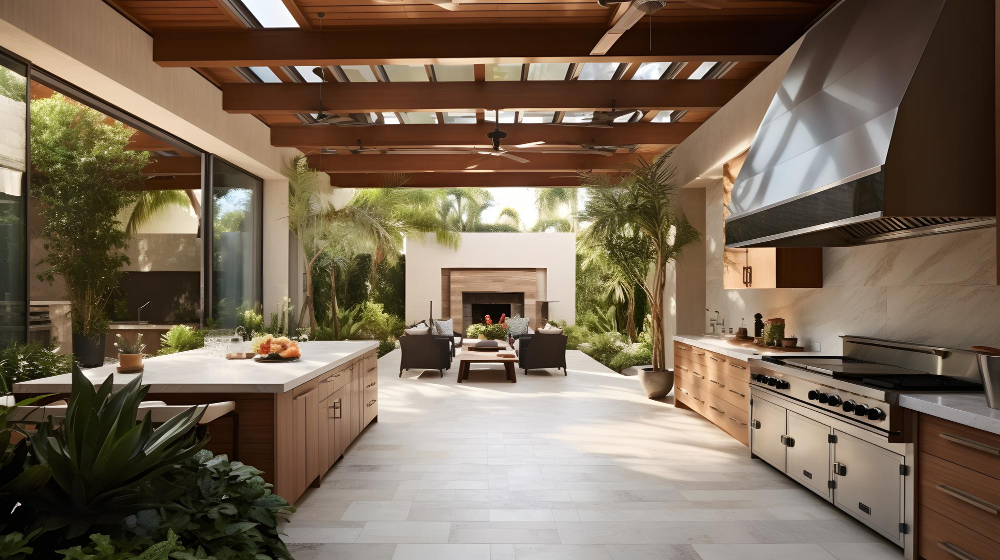
You want to ensure that it blends seamlessly with the rest of your outdoor space while also standing out as a focal point. Consider adding elements such as plants, flowers, or even water features to create an inviting atmosphere around your cooking area.
When designing the layout for your outdoor kitchen, think about how you can incorporate natural elements into its surroundings. For example, if you have a garden nearby or trees in close proximity, consider using materials that complement their colors and textures.
Lighting is crucial when it comes to creating ambiance in an outdoor setting. Incorporating soft lighting fixtures such as string lights or lanterns can add warmth and intimacy to any dining experience under the stars.
Building Regulations and Permits
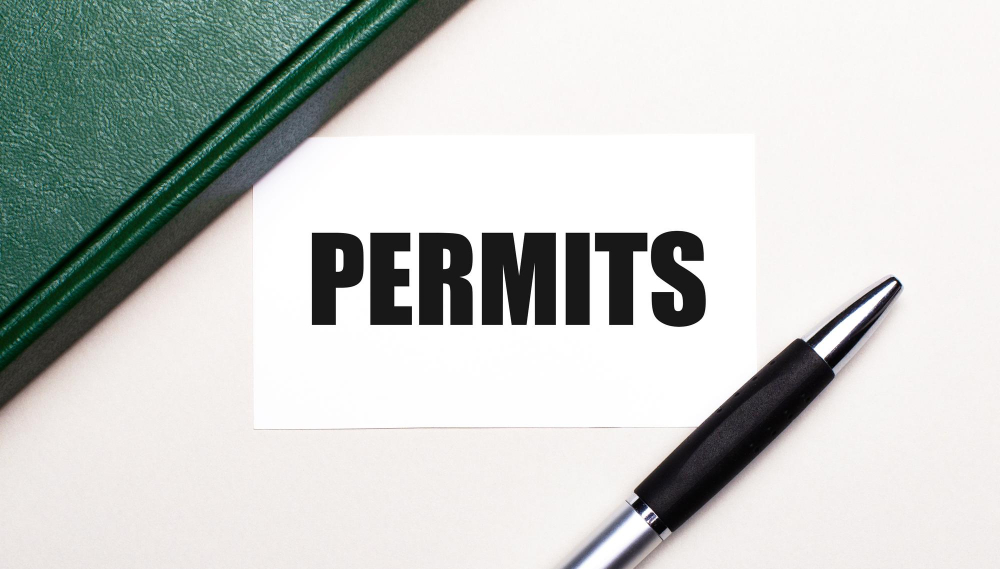
Depending on your location, there may be specific rules regarding the construction of outdoor kitchens. These regulations are in place to ensure safety standards are met and prevent any potential hazards.
Before starting any construction work, it’s crucial to check with your local authorities about obtaining permits for building an outdoor kitchen. Failure to obtain proper permission can result in hefty fines or even legal action.
Some areas have strict guidelines on where you can build structures like pergolas or gazebos that provide shelter over your cooking area. It’s important not only for compliance but also for safety reasons as well.
By taking care of these details beforehand will save you from headaches down the road when trying to sell your property or if something goes wrong during construction due to non-compliance issues.
FAQ
Where is the best place to put an outdoor kitchen?
The best place to put an outdoor kitchen is near the house, specifically close to the entrance to the home courtyard, to ensure convenient food preparation and transportation.
How far does an outdoor kitchen have to be from the house?
An outdoor kitchen has to be a minimum of 10 feet from the house, according to most building codes.
Where is the best place to put an outdoor BBQ?
The best place to put an outdoor BBQ is on a flat, clean surface away from flammable debris, rubbish bins, mulch, low-lying trees, hedges, and low-hanging branches.
What factors should be considered when choosing the location for an outdoor kitchen?
Outdoor kitchen location factors: accessibility, proximity to the main house, utilities, weather conditions, proper ventilation, safety, and view.
How important is proper ventilation and drainage in the placement of an outdoor kitchen?
Proper ventilation and drainage are crucial in the placement of an outdoor kitchen to ensure safety, comfort, and functionality.
What are some creative ways to integrate an outdoor kitchen with the existing landscape and design of a property?
Integrate an outdoor kitchen with existing landscape and design by incorporating matching materials, blending architectural elements, utilizing natural surroundings, and incorporating multi-functional spaces.

